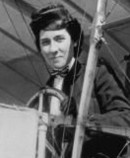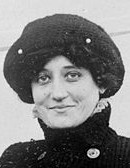| Name |
Date(s) |
Notes |
Bibliography |
| 1903 |
1903 |
1903 |
1903 |
| The Wright Brothers
|
December 17, 1903 |
Kill Devil Hills, North Carolina
Orville and Wilbur Wright win the race to put the first heavier-than-air powered craft into the air on this day, when their Wright Flyer soars into the air at Kill Devil Hills, NC (near Kitty Hawk.)
The first flight lasts 12 seconds, is piloted by Orville Wright, and the plane gets about 10 feet off the ground. Each brother makes two flights on this day.
It will take two more years before the Wright Flyer is perfected. |
. |
| 1905 |
1905 |
1905 |
1905 |
| Alberto Santos Dumont
|
1905 |
France
Alberto Santos Dumont, a Brazilian-born French aeronaut, who had been working with dirigibles before he turned to aircraft (he flew a dirigible around the Eiffel Tower in 1901), completes his first airplane design, and also that of a helicopter.
|
Le-1 |
| Wright Brothers |
June 23, 1905 |
USA
The Wright Flyer III makes its debut.
|
. |
| 1906 |
1906 |
1906 |
1906 |
| E. Lillian Todd

|
1906 |
America
Lilian Todd is the first woman to design and build an airplane. She unveils it in this year, but it is not airworthy. She continues to design and does propose some practical ideas - such as planes that could be collapsed for easy transport. She also founds the Junior Aero Club of America. |
Mo-1 |
Ernest Archdeacon |
July 1906 |
France
Frenchman Ernest Archdeacon founds the Archdeacon Prize, to be awarded to the first aviator to fly more than 25 meters. |
Le-1 |
Alberto Santos Dumont |
October 3, 1906 |
France
Santos Dumont pilots his 14-bis before a large crowd. He flies 60 metres (200 ft) at a height of two to three metres (10 ft). This well-documented event was the first flight verified by the Aéro-Club de France of a powered heavier-than-air machine in Europe. It was also the first public demonstration in the world of an aircraft taking off from an ordinary airstrip. Santos-Dumont is awarded the Archdeacon Prize. |
Le-1 |
| Alberto Santos Dumont |
November 12, 1906 |
France
Santos Dumont sets the first world record recognized by the Aero-Club De France, by flying 220 metres in less than 22 seconds. His feats cause excitement in France, and many individuals - both men and women, form a desire to learn how to fly. |
Le-1 |
| 1908 |
1908 |
1908 |
1908 |
| E. Lillian Todd

|
1908 |
America
Lilian Todd exhibits one of her planes at the 1908 Aeronautical Society exhibition in Morris Park, New Jersey. |
Mo-1 |
| Henry Farnam |
January, 1908 |
France
Henry Farman flies the first closed circuit |
Mo-1 |
Leon Delagrange
|
March, 1908 |
France
Leon Delegrange is the first pilot to take a passenger into the air - Henry Farman. |
Le-1 |
| Therese Peltier

|
July 8, 1908 |
France
Peltier is a sculptor and protege of French aviator Leon Delagrange. "Almost certainly flew an airplane alone, but never received a pilot's license." More than likely she flew a Farman biplane.
On this date, she is the passenger with Leon Delagrange when he breaks the record for duration in a flight: 30 minutes 27 seconds. www.earlyaviators.com/edelagra.htm |
Le-1 |
| Orville Wright |
August 8, 1908 |
Le Mans, France
Orville Wright demonstrates the Wright biplane in front of French officials in several flights, beginning om August 8 and extending into September. (In Le-1, the author says it is Wilbur.) |
Le-1 |
| Leon Delagrange |
September 1908 |
France
The press reports that sculptor and pilot Leon Delagrange is head of a new commercial organization, Compagnie d'Aviation, to "encourage aviation technology and promote exhibition flights."
He also presents 1,000 francs to the French National Aerial League as a prize for the first woman aviator to fly one kilometer, operating the machine on her own, with or without a passenger. |
Le-1 |
The Wright Brothers |
September 1, 1908 |
France
Wilbur Wright flies his aircraft for one hour and 21 minutes straight. This leads to the French government signing a contract with the Wright Company….and in the winter he will open the first aviation school for training military fliers at Pau, in southwest France.
One of the many people to witness these flights was Helene Dutrieu, and she decided to learn to fly. |
Le-1 |
| 1909 |
1909 |
1909 |
1909 |
| Helene Dutrieu

|
1909 |
French
After September, 1908 and into 1909, the 31-year old Helene Dutrieu learns to fly and flies the Clement-Bayard Company's Demoiselle, a plane designed by Alberto Santos Dumont. She is to be paid 2,000 frans a month to fly the plane. She makes her test flights at Issy-les-Moulineaux. However, the Demoiselle is too unstable, and she eventually cancels her contract with the company. |
Le-1 |
| Stella Society |
1909 |
French
French women form the Stella Society, to promote an interest in ballooning. The members of the society are socially prominent, and they report their activities in a column in the French journal, L’Aerophile. Most of the women are content with ballooning, and do not make the transition to piloting an airplane. |
Le-1 |
| Aero Club of France |
January 7, 1909 |
France
The Aero Club of France forms the first standards for a brevet (license).
The test for a pilot’s license requires three closed circuits of five kilometers each. In 1910, the test will also include landing and stopping within 150 meters of a designated point. In 1911, pilots will also be required to complete two circuits around a course, making figure eights to prove an ability to make both left and right turns.
|
Le-1 |
| Helene Dutrieu

|
April 9, 1909 |
Belgian
After quitting the Clement-Bayard Company, Dutrieu goes to work for Roger Sommer, who is building a biplane at Mouzon in the Ardennes. On this day, she flies the plane for 20 minutes, a record for women at the time. She does this because "it was easier to fly than to land." |
Le-1 |
| Helene Dutrieu

|
April 19, 1909 |
Belgian
Helene Dutrieu flies with a female passenger, and claims it to be a first. Other women pilots also submit such claims of "firsts" and primacy is not really known. |
Le-1 |
| Helene Dutrieu

|
May, 1909 |
Belgian
Helene Dutrieu goes to Odessa, Russia with Sommers. However, one day she clips a chimney when coming into land, and crashes the plane. Sommers fires her. |
Le-1 |
| Louis Blériot |
July 25, 1909 |
France
French pilot Louis Blériot flies across the Ebglish Channel from Calis to Dover, "a fight that fired imaginations everywhere and changed the way people viewed the world." Among others, German woman Melli Beese is inspired to learn to fly by this exploit. |
Le-1 |
| Marie Marvingt

|
September, 1909 |
French
Roger Sommer takes Marie Marvingt up in the air for an airplane ride. In early 1910, she will sign up for flying lessons with Hubert Latham to fly his Antoinette, a monoplane. |
Le-1 |
| Comde de Lambert |
October 18, 1909 |
France
The Comte de Lambert flies over Paris in a Wright biplane and circles the Eiffel Tower twice at an altitude of 400 meters before landing. |
Le-1 |
| Raymonde de Laroche

|
October 22, 1909 |
Chalons, France
born August 22, 1886 in Paris
Laroche pilots a heavier-than-air machine into the air alone, and is "generally recognized as the first woman to do so." She pilots a Voisin, designed by Charles Voisin and his brother Gabriel.
She will be issued her license five months later. |
Le-1, Mo-1 |
| Marie Marvingt

|
October 26, 1909 |
Marvingt, who earned her balloonist's license around 1901 (#145) makes a balloon trip, in the L'Etoile Filante" (Shooting Star) from Nancy across the North Sea to England. She is accompanied by Colonel Emile Garnierr as passenger and assistant. |
Le-1 |